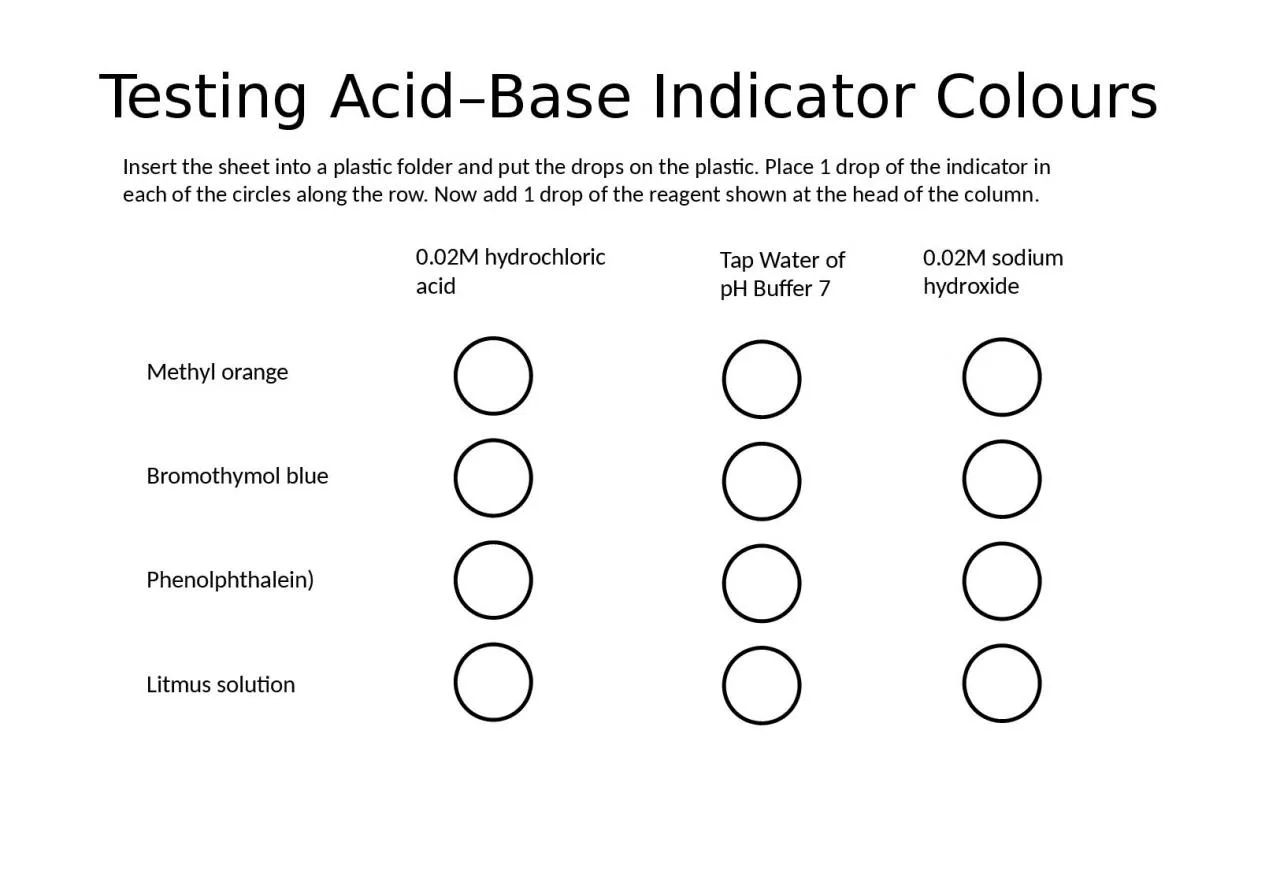

002M hydrochloric acid 002M sodium hydroxide Litmus solution Methyl orange Phenolphthalein Tap Water of pH Buffer 7 Insert the sheet into a plastic folder and put the drops on the plastic Place 1 drop of the indicator in each of the circles along the row Now add 1 drop of the reagent sho ID: 1011611
Download Presentation The PPT/PDF document "Testing Acid–Base Indicator Colours" is the property of its rightful owner. Permission is granted to download and print the materials on this web site for personal, non-commercial use only, and to display it on your personal computer provided you do not modify the materials and that you retain all copyright notices contained in the materials. By downloading content from our website, you accept the terms of this agreement.
1. Testing Acid–Base Indicator Colours0.02M hydrochloric acid0.02M sodium hydroxideLitmus solutionMethyl orangePhenolphthalein)Tap Water of pH Buffer 7 Insert the sheet into a plastic folder and put the drops on the plastic. Place 1 drop of the indicator in each of the circles along the row. Now add 1 drop of the reagent shown at the head of the column.Bromothymol blue
2. Indicator reactions are reversible Add 2 drops of 0.01M hydrochloric acidThe indicator solutions (1 drop) is added to circle 1 or a well-plate, You can use. methyl orange, bromothymol blue, phenolphthalein, red cabbage or other natural indicators.1Take one drop from 1, add it to circle 2 and add 2 drops of 0.01M sodium hydroxide2Insert the sheet into a plastic folder and put the drops on the plastic.Stir solutions with a wooden splint.34Take one drop from 2, add it to circle 3 and add 2 drops of 0.01M hydrochloric acid. Take one drop from 3, add it to circle 4 and add 2 drops of 0.01M sodium hydroxide5In circle 5, can you make an intermediate colour? It is quite tricky. You need to go back and forth, but do you have the patience?Extension: Use pH paper or a pH meter to find the pH of this solution. Place 1 drop of indicator in circles 1 2 3 and 4.
3. Bromothymol blue (BB)A1 B1 C1 D1 E1Making a Universal IndicatorMethyl orange(MO)Phenolphthalein(PP)Mixed indicator:BB = 10 dropsMO = 5 dropsPP = 5 dropsCommercial Universal IndicatorpH = 1Strong acidpH = 4Weak acidpH =9Weak AlkalipH = 13Strong Alkali Put 2-3 drops strong acid into circle A1 to create one large drop. Repeat for each circle A2 – A5, BI to B5, etc. with the relevant solutions.Put 1 drop of bromothymol blue into each circle A1 to E1; 1 drop of methyl orange in A2 – E2 and 1 drop of phenolphthalein in A3 – E3.Make a mixture of indicators (do this in the glass vial or well plate) using the recipe in green-shaded italics below.. Put 1 drop of your mixed indicator into each solution in circles A4 – E4. use a commercial UI for A5 to E5.pH =7NeutralInsert the sheet into a plastic folder and put the drops on the plastic.A2 B2 C2 D2 E2A3 B3 C3 D3 E3A4 B4 C4 D4 E4A5 B5 C5 D5 E5
4. Neutralization; the reaction between sodium carbonate and citric acidInsert the sheet into a plastic folder and put the drops on the plastic.Add 2 drops of Universal Indicator and enough drops of water to just fill the circle.Add crystals of citric acid to this little circle on the right. Make sure they do not spill into the big circle.Add crystals of anhydrous sodium carbonate to this little circle on the left. Make sure they do not spill into the big circle.Now use the flat end of a wooden splint to push the crystals into the edge of the large puddlesWatch carefully the colour changes and other effects over the next 4 minutes to 6 minutes.12345
5. A pH profile of a Natural IndicatorpH1pH2pH3pH4pH5pH6pH7pH8pH9pH10pH11pH12pH13pH14Insert the paper into the plastic folderPlace the correct buffer solution onto the relevant circleAdd one drop of the indicator to each circleCut a wooden splint to a point and stir each circle before photographing the results